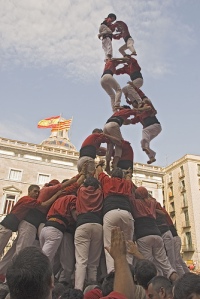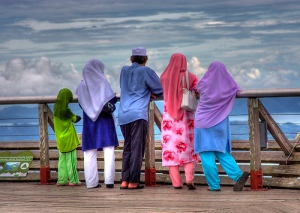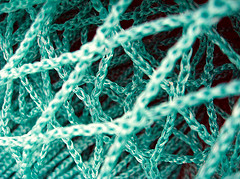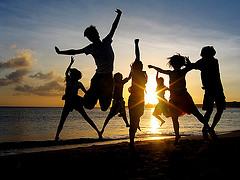 Social capital is a powerful resource for individuals and communities. For individuals embedded in dense social networks, these networks and the attendant norms of trust and reciprocity strongly shape individuals’ ability to land jobs, earn higher salaries, and be happier and healthier. But, even for those not in the networks, having neighbors who know and trust one another affords benefits in some domains: better performing local government, safer streets, faster economic growth and better performing schools, among other public goods.
Social capital is a powerful resource for individuals and communities. For individuals embedded in dense social networks, these networks and the attendant norms of trust and reciprocity strongly shape individuals’ ability to land jobs, earn higher salaries, and be happier and healthier. But, even for those not in the networks, having neighbors who know and trust one another affords benefits in some domains: better performing local government, safer streets, faster economic growth and better performing schools, among other public goods.
For sure social capital can be used toward negative ends: Al Qaeda, the Crips and the Bloods, the Michigan Militia are all examples where group members can accomplish things that they could not accomplish individually (because of group social capital). That said, the literature supports that the vast majority of what social capital is used for is to produce positive ends, not negative ones.
But why? What makes social capital so powerful?
Robert Putnam and I had always focused on information-flows as the key mechanism. So these social networks:
- enable individuals to access valuable information: how to get something done, hear of job leads, learn how better to promote one’s health, find out what is happening in a community, etc.; or
- help individuals find partners for joint economic transactions (e.g., to know with whom to partner in business, to close a sale to a friend or a friend of a friend, to locate a neighbor with whom one can exchange tools or expertise); or
- spread reputations of members (or neighbors or local merchants) which causes all people in these networks to behave in a more trustworthy manner and facilitates altruism. There is always a short-term gain to be had from cheating someone, but if the social networks quickly spread the information that one cannot be trusted, this short-term gain is swamped by the lost future opportunity to do business with others; thus it becomes more rational to be honest and trustworthy in communities (physical or otherwise) with strong social networks. Individuals are also likely to be kinder and more altruistic toward others because they know that “what goes around comes around” in densely inter-connected networks and communities; and
- facilitate collective action: it is easier to mobilize others around some shared goal like politics or zoning or improving trash pick-up if others in the community already know and trust you, rather than your having to build those social relationships from scratch.
But Connected (by Nick Christakis and James Fowler) raises a different frame for thinking about this issue: network effects or contagion. Are there properties of the networks themselves that help spread practices, independent of the flow of information? This is difficult to answer fully since much of their evidence comes from the Framingham Heart Study where they know who people’s friends are but not what they are doing with each other or what they are saying to each other.
That said, some of their results can be explained by information flows (e.g., political influence, or getting flu shots), but some seem likely to be working through other channels and not through information-flows (e.g., happiness or loneliness cascades).
In these “network effects” or contagion, Fowler & Christakis typically find that the strongest “network” effects are directly with one’s friends (one degree of separation), but these effects also ripple out two more levels to friends of one’s friends (two degrees) and friends of the friends of one’s friends (three degrees). As one would expect, much like a stone dropped in a pond, the ripples get smaller as one moves out. In fact they refer to the “Three Degrees of Influence” Rule that effects are typically only seen up to three degrees out and not further: in the spread of happiness, political views, weight gain, obesity, and smoking. For example, in happiness, if one is happy, one degree out (controlling for other factors), one’s friends are 15% happier, at 2 degrees of separation they are 10% happier, and they are 6% happier at 3 degrees of separation. For obesity, the average obese American is more likely to have obese friends, one, two and three degrees of separation out, but not further. Quitting smoking has diminishing effects out to three degrees. For political influence, they note a “get-out-the-vote” experiment that shows that knocking on a stranger’s door and urging the resident to support a recycling initiative had a 10% impact on his/her likelihood to vote for the initiative; what was noteworthy to Christakis and Fowler is that the door-knocking made the spouse (who was not at the door) 6% more likely to support the recycling initiative based on communication with his/her spouse. They conjecture that if this 60% social pass-through rate of political appeals (6% for spouse vs. 10% for person answering door) applied to one’s friends and if everyone had 2 friends, then one person urging friends to vote a certain way would have a 10% impact on one’s friends, a 6% impact on one’s friends’ friends (2 degrees) and a 3.6% impact 3 degrees out. Multiplying these political effects all the way through, one vote could create a 30x multiplier. [The example is eye-opening and suggests that voting and political persuasion may be less irrational than thought, but also is based on a huge number of assumptions and assumes no cross-competing messages from friends.]
In an experiment on altrusim (explained in this post) Christakis & Fowler found that $1.00 of altruism, ultimately produced $1.05 of multiplier effect ($.20 one ripple out with 3 others and $.05 of altruism two ripples out with 9 others).
Christakis and Fowler, in their book, talk about contagion effects in voting, suicide, loneliness, depression, happiness, violence, STDs, number of sexual partners, binge drinking, back pain, and getting flu shots, among others. [One summary of many of their findings, which they note, is “You make me sick!”]
Why do these effects only reach out 3 degrees of influence? Christakis & Fowler suggest 4 potential explanations.
1) intrinsic decay: C&F liken this to a game of telephone where as the information gets repeated, the content gets lost, or the passion and knowledge of the initiator gets dissipated.
2) Instability of ties: because of what is known as “triadic closure“, if A is friends with B and B is friends with C, it is likely that A will become friends with C. Because of this, closer-in ties between people have more routes connecting them, and further out ties are more dependent on only one pathway connecting them. For example, assume Abby and Fran were friends 3 degrees removed via Bert and via Charles. If any of these intervening friendships end (say Bert is no longer friends with Charles), Abby loses her tie to Fran. Thus, these outer ties are much less stable and averaged across all the “3 degrees of influence” friendships, many more may have zero effect because the path of influence dies out as friends change.
3) cross-information: as one gets further out away from you, say the friends of the friends of your friends, all of these folks are getting lots of cross-stimuli from lots of other sources (many of which may come from different clusters with different habits or values) and these cross-stimuli start to cancel each other out.
4) evolutionary biology: C&F note that humans evolved in small groups that had a maximum of three degrees of separation so it may be that we became more attuned to being influenced by folks who were in a position to alter our gene pool.
So what are the network influences independent of communication. There seem like 6 possible channels, and often it is hard to separate one from the other, although some may make more sense for the spread of behaviors and others may make more sense for spread of attitudes or emotions:
1) homophily: “Homophily” is the practice of befriending others like you — “birds of a feather flock together.” Being friends with people who are different than you can be stressful. This is why in mates and in friends we are likely to choose others with whom we have a lot in common — think of arguments you’ve had with friends about where to go for dinner or what is right or wrong with the world when those friends have very different tastes or politics. For this reason, one reason for increased clustering over time of obese people or smokers or binge drinkers is that it is stressful to be in groups where one is the minority and either constantly noodging others to change their behavior or else your finding yourself frequently doing what your friends want to and what you do not (e.g., eat fast food, smoke, or listen to heavy metal rock music). As a consequence, people may vote with their feet and form new ties or strengthen ties with others with whom they have more in common.
2) norms/reference groups/culture/peer pressure: we often measure the reasonableness of our behavior against our friends. For example, if our teen friends have all had 6 sexual partners in the last year, then repartnering seems far more normal than if one is friends with a group that is heavily monogamous. Ditto with obesity or smoking or other possible traits or behaviors.
3) subconscious/imitation: as suggested with “emotion” below, sometimes we mirror others’ behavior or emotions without even thinking about it. C&F say it makes sense to think of people as subsconsciously reacting to those around them without being aware of any larger pattern. They talk about processes by which a “wave” at a sporting event takes place, or fish swim in unison, or geese fly in a V-formation, or crickets become synchronized — all of these happen by individuals mirroring those around them. And in the process, emergent properties of the group arise (much like a cake takes on the taste unlike any of its individual ingredients).
4) emotions: C&F note that emotions actually affect our physical being — our voices, our faces, our posture. In experiments, people actually “catch emotions”: others become happier by spending time around happy people or sadder by hanging out with depressed individuals. In experiments, smiling waiters get bigger tips. It seems quite plausible that cascades like loneliness, happiness, depression, etc. could spread simply from emotional states, independent of any information flowing through these friendships.
5) social invitations for shared action: friends often invite friends to do things — that’s part of friendship. For behaviors, one of the ways they can spread through networks is that, for example, thin friends could invite friends to exercise more, or obese friends could encourage friends to get ice cream together, or smokers could encourage others to leave the dance for a cig.
Connected notes that it is often hard, for example, to tell imitation and norms apart, “When a man gives up his motorcycle after getting hitched, is he copying his wife’s behavior (she doesn’t have a motorcycle) or adopting a new norm (the infernal things are unsafe?)”
Connected also notes how behaviors or attitudes can spread several social links out, even without the intervening link changing. They suggest that Amy could have a friend Maria who has a friend Heather. (Amy and Heather don’t know one another.) Heather gains weight. Maria, who really likes Heather, becomes less judgmental of her weight and gradually less judgmental of obesity in general. Maria doesn’t change her behavior but when Amy stops exercising with Maria, Maria is less likely to pressure her to resume. Thus Heather’s obesity changes Amy via Maria (by Maria no longer urging her to keep exercising), but Maria doesn’t change her behavior and Amy and Heather don’t know one another.
It’s interesting stuff to ponder and makes one think more expansively about the role and mechanisms of social capital. It also evokes a conversation with a Saguaro Seminar participant back in 1998 concerning whether black kids and white kids doing sidewalk painting together on the steps of an art museum could promote inter-racial trust, even if the black kids and white kids didn’t know each other, didn’t talk to one another and never met again. [My hunch is yes, depending on the strength of their pre-existing beliefs about inter-racial trust, but that talking could make the exchange far more powerful.] Another Saguaro participant wondered whether singing together in a chorus helps build social capital, even if one never has a conversation directly with another member of the chorus. (In the latter example, in addition to being highly unlikely, you are at least getting some non-verbal information over time from the other choral members about their trustworthiness: do they come regularly and on time, do they respectfully listen to and follow the choralmeister?)
I welcome your thoughts.
For more on the network effects, read pp. 24-30, 25-43 and 112-115 in Connected.






